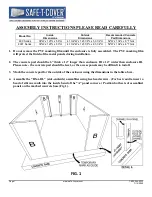
10
Closing the closure
10.1
Remove the outer bag and place the Silica gel in the closure
(be careful, do not disturb any fiber or tube routing)
10.2
Place the o-ring back on a clean base and place the dome on
top of it.
10.3
Close with clamp.
11
Important steps during installations
•
Make sure that grooves on the wraparound groove plate are clean.
•
Clean the fibers.
•
Be sure that fibers are not stored to tight in the trays, to prevent
stress on the fibers.
•
Loose tubes routed up to the tube holder should be routed in such
a way that one still has complete acces of the stored tubes
between UMS profile.This is needed for later routing of loose
tubes from the loops to the tube holders without creating crossings
and without creating disturbtions on the loose tubes allready
routed up to the tube holders.
•
Use correct lengths in the tubeholder.
•
Make sure not to loose ID.
•
Use only 45mm long SMOUV.
•
Be secure when preparing window cut on loose tube cable for
storing uncut fibers.
•
Avoid in all cases crossings of fibers and loose tubes in the cable
brackets.
•
When using cables with a diameter smaller than 12mm in a cable
bracket,bend the sharp edges towards the cable and use some
tape around the bracket to protect the heatshrink.
•
Replace the Silica gel each time the closure has been opened.
•
Do not place the aluminum protection foil too deep in the
heatshrink.
12
Re-arrangement
Avoid to pull fibers inbetween groove plates.
Avoid fiber movement between tubeholder and first containment lip
on the routing block.
Take special care rearanging fibers from E to O side or reverse.
If accidentaly active fibers are removed from the containment
devices,reposition them carefully.
TC 574/IP/2 07/00
Tyco is a trademark. Teflon is a trademark of E.I. du Pont de Nemours. Velcro is a trademark of Velcro Industries B.V.
The information given herein, including drawings, illustrations and schematics which are intended for illustration purposes only, is
believed to be reliable. However, Tyco Electronics makes no warranties as to its accuracy or completeness and disclaims any liability
in connection with its use. Tyco Electronics’ obligations shall only be as set forth in Tyco Electronics’ Standard Terms and Conditions
of Sale for this product and in no case will Tyco Electronics be liable for any incidental, indirect or consequential damages arising out
of the sale, resale, use or misuse of the product. Users of Tyco Electronics products should make their own evaluation to determine
the suitability of each such product for the specific application.
Tyco Electronics Raychem NV
Telecom Outside Plant
Diestsesteenweg 692
B-3010 Kessel-Lo, Belgium
Tel.: 32-16-351 011
Fax: 32-16-351 697
www.tycoelectronics.com
www.telecomosp.com

































